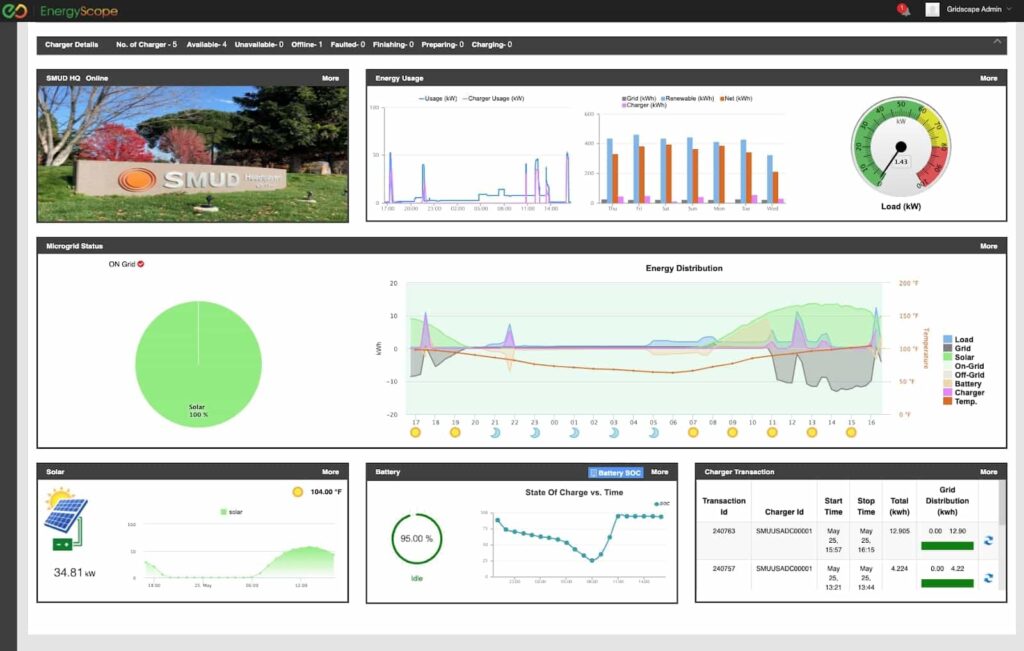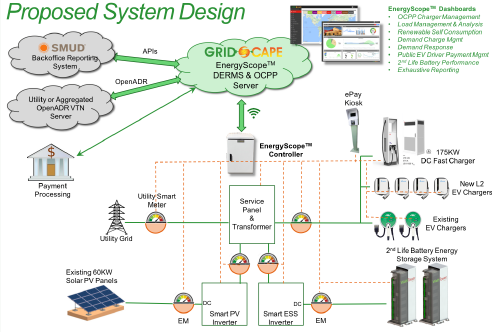Local sustainable power plant-
helping SMUD reach its carbon neutrality goal by 2030
Sacramento Municipal Utility District (SMUD)
SMUD in partnership with Gridscape has deployed an integrated solution with EV charging, solar PV and battery storage system at its headquarters.
The goal of this project is to demonstrate site level load variability management, increased renewable energy self-consumption, offer scheduled and active control demand response capacity to grid, peak load reduction, ramp rate control, customer demand charge management, and evaluate second-life battery performance.

Why local sustainable power plant (microgrid) make sense for SMUD?
The Sacramento Municipal Utility District (SMUD) is the nation’s sixth-largest community-owned electric utility. SMUD provides reliable, affordable electricity to most of Sacramento County and portions of Placer County, in central California. It serves a population of 1.5 million and a service area of 900 square miles. SMUD has set an ambitious goal of providing 33% of its energy from renewable sources by 2020 and is well on target to achieve that goal.
Benefits for SMUD
- Green initiatives and policies boost: City fleet operators also have eyes on electric. Cities are obligated to reduce pollution, which is why many cities are electrifying transit and light duty fleets, and are piloting everything from public buses to police cars.
- EV Charging infrastructure: As electric vehicles gain traction utilities like SMUD must drive energy infrastructure upgrades, balance distributed energy resources (DER), and remodel the customer-utility relationship.
- Savings: Cost is always a consideration for utilities and cities and microgrids can help keep the cost low.
- Providing societal benefits: Green jobs generation, quality of life and local economy boost.
- Support California: Supporting California’s loading order to meet energy needs first with energy efficiency and demand response also align itself towards low emission pursuits.

SITE: Utility Headquarter Commercial Building / Parking Lot / Public Charging
Project
Infrastructure:
- 100 KW Solar Carport System
- 112 kWhr 2nd Life Li-On Energy Storage System
- EnergyScope™ Microgrid Controller & DERMS
- One Ultra-fast 175 kW DC Fast Charger (ABB)
- Ten AC L2 EV Charging Stations
- 21 KV Microgrid Reclos
SMUD has upgraded the existing 150kW transformer to a 300 or 500kW transformer. The existing switchgear and conduit has been utilized for this project. The microgrid is powered by Gridscape EnergyScope Microgrid controller and a 60kW/120kWh – 2-hour second life battery storage system.
Operations:
- Public Charging Open to public since Dec 2019
- Total Number of Charging transactions: 2,035
- Total Revenue Collected: $4,402
- Total Energy Dispensed: 22.2 MWh
- Total Grid Power Import: 0.075% of 22.2MWh (incl Demand Response events)
Design
The project will be based on following figure system integration architecture for Gridscape projects with minor modifications/ alterations.

Proposed System Integration Architecture
About Gridscape:
Gridscape is the largest and a well-established name specializing in developing and deploying standards-compliant future-proof products and solutions for renewable energy microgrids and fleet charging. Intended to serve as a locally produced sustainable power plant, these microgrids allow sites to become less reliant on the grid by using local sources of energy. They can provide as much as 90% independence from the grid energy, and thus reduce overall energy cost & provide backup clean emergency power during PSPS or other power disruption events. Gridscape with its ‘Product Centric’ approach to microgrids integrated with fleet EV charging solutions allows for lower cost of installation and reduces the time for deployment by substantially lowering integration issues. It expects to deploy and operate over 35 microgrids in California public and commercial facilities over the next 12 months.
Unlike traditional microgrid developers, Gridscape employs a holistic product-centric, artificial intelligence (AI) based software-driven approach to designing, deploying, and managing microgrids. It also integrates Electric Vehicle (EV) charging and other controllable loads into its solution. Through its broad partnerships with various Tier 1 and Tier 2 financiers, design engineering firms, energy storage manufacturers and other renewable energy product providers, it leverages the best-in-class mix of technology and finance to provide maximum return on investment to customers.
Gridscape’s solution is unique, and it differentiates from traditional systems in following manner.
Product Centric Approach (vs Project Centric Methodology) for scalability, maintainability, and longevity of microgrid assets
Software driven architecture resulting into no technology obsolescence and ability to adapt to changing PG&E tariffs and distribution grid conditions.
Dynamically configurable with an ability to change the microgrid operational modes on demand
Energy Information System: A cloud-based distributed energy resource management system (DERMS) that includes
1
Smart AI-based energy management and optimized load and generation dispatch; and
2
Very powerful visualization dashboard for accessing real time and historical data about PV, Storage and EV charging stations.
Inherently Integrated with EV charging infrastructure
Full Energy Management including demand charge reduction, TOU arbitrage, grid services.
Integration with various Cloud platforms such as Google, Amazon for grid services and load management.
Gridscape EnergyScopeTM Dashboards

